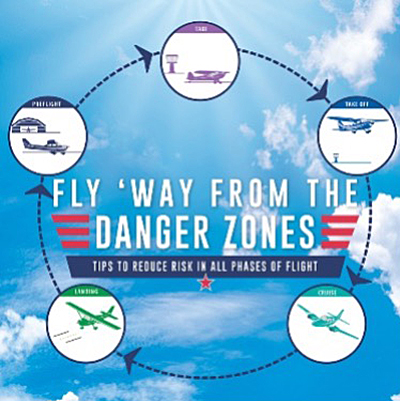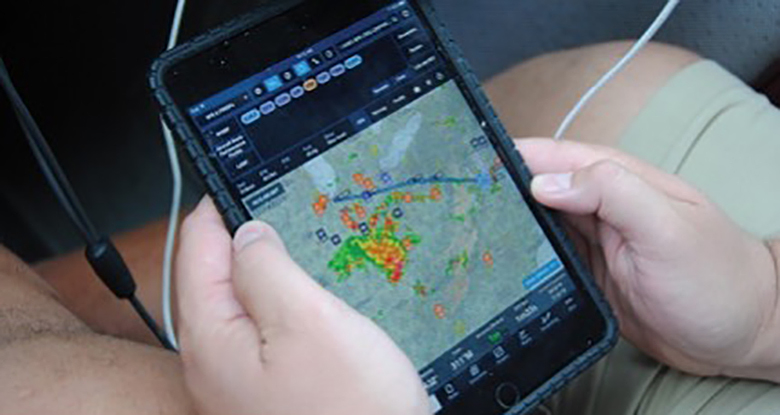How Do You Do?
Practical Ways to Practice Risk Management
By Susan K. Parson, FAA Safety Briefing Magazine Editor
Inbrowsing the web last night, I stumbled upon what looks to be an endlessly fascinating collection of “how to” instructions. In a “How to Do Everything” piece that I quickly bookmarked for more leisurely exploration, New York Times writer Malia Wollan shares seven years of wisdom collected in her work on the paper’s tip column. The author covers everything from the whimsical (e.g., “How to Fake a British Accent”) to the practical (“How to Rescue a Cat from a Tree”) to the philosophical (“How to Become Less Angry”). Given the just-passed summer season’s scary headlines from several of the nation’s popular beaches, those who like splashing in the surf might want to read “How to Survive a Shark Attack” before your next trip to the ocean. (Note: For the full list of topics, see the Learn More section for a link to the article.)
One topic I didn’t find in Wollan’s grid is “How to Manage Risk in Aviation.” I therefore propose to take a few minutes to offer a short primer on that very subject.

Power + Responsibility
Many of us in the GA community find ourselves operating either as the sole occupant or at least the only pilot aboard the aircraft. Even if your passenger list includes another pilot, someone (you, for purposes of this discussion) has to be the legal pilot-in-command (PIC). FAA regulations (14 CFR section 91.3) clearly state that the PIC is “directly responsible for, and is the final authority as to, the operation” of the aircraft. This rule gives the PIC plenty of power, which comes with plenty of responsibility. The good news is that you also have plenty of resources to help you exercise your PIC power in a safe and responsible way.
The key is to master a skill that the FAA calls “single pilot resource management” (SRM). Let’s start with a definition. The FAA Risk Management Handbook (FAA-H-8083–2) calls SRM the art of managing all the resources, both those onboard and those from outside sources, to ensure a successful flight. SRM is about gathering information, analyzing it, and making decisions. The pilot must be able to competently perform a number of mental tasks in addition to the physical task of basic aircraft control. These include:
- Situational awareness
- Task management
- Automation management
- Risk management
- Aeronautical decision-making (ADM)
- Controlled-flight-into-terrain (CFIT) awareness
The Risk Management Handbook also offers a very useful observation:
Learning how to identify problems, analyze the information, and make informed and timely decisions is not as straightforward as the training involved in learning specific maneuvers. Learning how to judge a situation and “how to think” in the endless variety of situations encountered while flying out in the “real world” is more difficult. There is no one right answer in ADM; rather each pilot is expected to analyze each situation in light of experience level, personal minimums, and current physical and mental readiness level, and make his or her own decision.
Now that is no small challenge, especially for GA pilots whose aeronautical experience may be limited. In many flights I have made in airplanes that lacked automation, solid training provided a firm foundation for task management and situational awareness. Looking back, though, I recognize that I would have been much safer with a structured approach for gathering and analyzing information for both preflight and en route decision making.

Having enough fuel to give you options is a good strategy. (Photo by Civil Air Patrol Col. Jane Davies)
A Structured Approach
To apply the tenets of SRM in a structured way, the Risk Management Handbook suggests regular evaluation of: (1) Plan, (2) Plane, (3) Pilot, (4) Passengers, and (5) Programming. Let me hasten to assure you that the point of the 5P approach is not to memorize yet another aviation acronym. Instead, you might simply write these words on your kneeboard, or add a 5P reference to your checklist for key decision points during the flight. Items to consider include:
Plan
Basic elements of cross-country planning: weather, route, fuel, current publications, etc. Since any of these factors can change at any time, review and update the plan at regular intervals.
Plane
Onboard equipment constitutes an important resource. Today’s technology offers an incredible range of information to assist with overall situational awareness, navigation, weather information, and much more. The key is to know what information is available and how to access it without diverting your attention from essential aircraft control duties. Be proficient with all installed equipment, and familiar with performance characteristics and limitations. Monitor systems and instruments in order to detect any abnormal indications at the earliest opportunity.
Pilot
The “IMSAFE” checklist is a handy tool for identifying hazards to your fitness for flight. You should also take the time to develop, and then periodically review/revise, a set of personal minimums tailored specifically to your own knowledge, skill, and experience. (See Learn More for a link to tips on developing your own personal minimums.)
Passengers
Passengers can be a great help by performing tasks such reading checklist items, watching for traffic, and listening for ATC radio calls. You might also teach regular passengers to assist with switching radio frequencies and basic programming for moving map and multifunction displays. Internal resources also include checklists and verbal briefings. Be mindful, though, that passenger needs — e.g., physiological discomfort, anxiety, or desire to reach the destination — can create potentially dangerous distractions.
Programming
Electronic displays, moving map navigators, and autopilots can reduce workload and increase situational awareness. However, be mindful that the task of programming or operating this equipment can create a dangerous distraction.

Using all available resources is important in managing risk.
Is there another way? Of course! As the NYT writer’s article implies, there is always more than one way to rescue a cat, build a treehouse, sing in tune, or whatever else you want to attempt. You may already have your own tried-and-true “how to” in this area, or you may be new to the idea with no established risk management method. Either way, please peruse the SRM description in the FAA Risk Management Handbook for potentially useful nuggets. Whatever SRM approach you choose, though, use it consistently and remember that solid SRM skills can significantly enhance the safety of “crew of you” flights.
Learn More
- “How to Do Everything” in August 26 New York Times(paid subscription required)
- FAA Risk Management Handbook(FAA-H-8083–2)
- FAA Safety Briefing, Sep/Oct 2019 (Checklist)
- “Your Safety Reserve,” FAA Safety Briefing, Mar/Apr 2015
Susan K. Parson (susan.parson@faa.gov) is editor of FAA Safety Briefing and a Special Assistant in the FAA’s Flight Standards Service. She is a general aviation pilot and flight instructor.
Reprinted with permission from FAA Safety Briefing. Visit the Flight Safety Briefing website: https://www.faa.gov/news/safety_briefing/.



